Ready 2 Roll
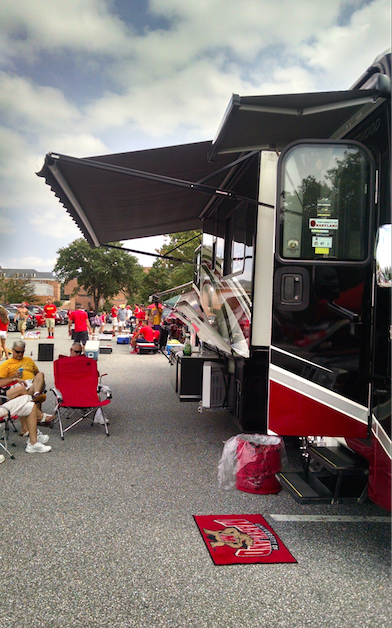
(The Fire Chief’s Class A Fleetwood Excursion Motorhome in his usual position in the parking lot adjoining Capital One Field at Byrd Stadium yesterday).
We were tailgating at Byrd Stadium in College Park yesterday. People were throwing footballs and getting in the mood for a three-thirty kick off. The smell of grilling hung in the humid air under mostly cloudy gray skies. We sat in back of the Surbaru Outback in folding chairs and talked about the world, and what was going to happen next.
No, this is not going to be an essay on football. I am not sure any of us cared about the ultimate result of the game- the Terps were going to win, that was a given, but in the spirit of the America on Wheels theme of the current stream of stories, we all got to the game on wheels, and wheels and what was mounted on them was the preoccupation of the afternoon.
Then a big silver truck approached us and turned into the space a couple down from where we were parked, pulling forward to take the front space for the truck and the rear space for the trailer. The owners hopped out, screwed down the leveling shaft on the hitch and began to transform their world.
No kidding. The awning rolled out. The grill swung out to the side of the rear. The door to the private bathroom was unlocked. The queen size bed on the other side of the trailer was not deployed- not enough drinks had been served from the full bar and flatscreen media center on the side facing us with the drop-down stainless steel counters.
A Terrapin, the mascot of the University of Maryland, was painted on the sides of the trailer and flew proudly from the flag raised on the telescoping pole on the side of the trailer. Two Honda generators provided full 60-hz power to run everything. Not bad.
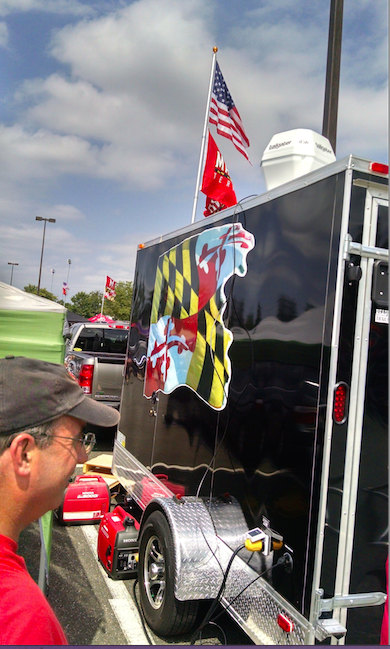
The owners were pretty proud of their new toy. They had picked it up from an outfit called “Ready 2 Roll Trailers” just a week before, and were breaking in the new tailgate capability.
We were chumps, and had been talking about trucks and the things you can tow with them, we went over to scope out the rig. We joined a tour in progress as the Honda generators went efficiently about their business of powering the cooling system, operating the satellite dish and powering the television.
Lile, one of the owners, gestured at the mural that covered the side of the trailer over the fold-down bed. “This is the Hall of Fame model,” he said proudly. With the twelve foot bed, went completely custom on this one.”
I was impressed. I looked it up later- the base Hall of Fame package went for over $20K and you could certainly push that north with the custom paint and the rest of it.
I kept going after the tour and walked over to the Class A motorcoach and introduced myself to the Fire Chief, for that is what the proud owner used to do before retiring. He was not drunk- not yet- but was expansive and proud of his rolling hobby. I got the complete run-down on the rolling home- I could call it a bus, but that would do no justice to the two-bedroom, two-bath rolling palace.
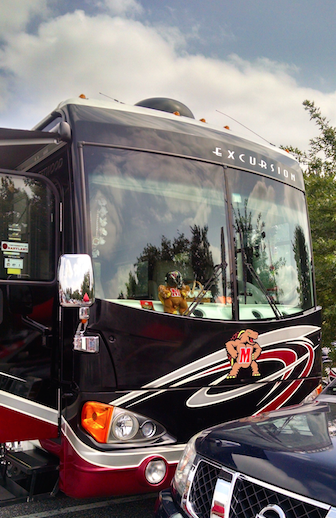
The Chief had bought the Fleetwood Excursion new in 2007 at the big RV convention in Hershey, PA. $175 grand,” he said. “But if you are looking for one, I recommend searching in Florida. The folks retire down there, the guy dies and the widow doesn’t know what to do with the motorcoach. You can get some real deals.”
We went on to discuss the custom garage he had built on his property to house the monster, and the dual wash racks to fill and clear the holding tanks and the general excellence of the Fleetwood, except for the electric level motors which totally suck and cost $400 to fix every time he looks at them crossways.
It was a great visit, and I realized as I walked back towards the tailgate trailer that the key to all this is exactly like boats. The best thing in life is not owning a boat- that is an immense amount of work, and essentially just a hole in the water that the owner attempts to fill with money. The best thing is to have a friend who has a boat.
We decided that we were going to park next to the tailgate trailer the rest of the season, and really get to know our new friends. With the big screen display under the awning, there really was no reason to have to walk all the way over to the stadium at all.
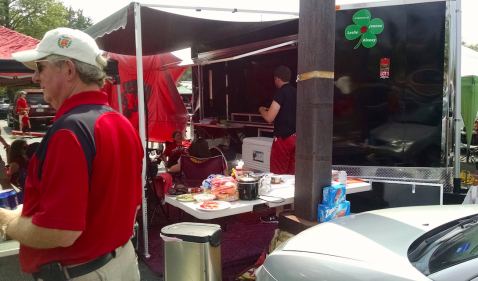
Copyright 2014 Vic Socotra
www.vicsocotra.com
Twitter: @jayarte303
Class A
I have been thinking about used trucks with an eye toward their unique capabilities, and one thing led to another as it always does. Here is something that directly impacts the relevant seasonal equation as we prepare to put away our straw hats, seersucker suits and white shoes, courtesy of the Old Farmer’s Almanac:
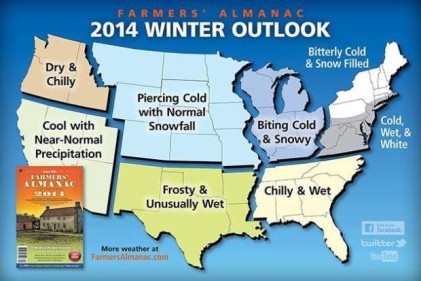
I just can’t do another one of those winters, and the prediction for the Old Dominion as Cold, Wet and White is not what I am looking for. So where does that leave a snow bird? Driving along the highways of the Great Midwest I could see them in their stately motor homes, lumbering along the roads with such imposing gravitas, even towing second automobiles.
When I was in Key West during the winter of our discontent with the Polar Vortex fronts whistling through Washington every two weeks, I saw that there was a mobile community of retirees parked at the beach at the Naval Air Station. I was intrigued then, and am more intrigued now, based on the prospect of another hard winter.
I looked into the concept. Apparently they come in distinct classes of vehicles. The bottom line of self-propelled motorhomes is the “Class C,” which are motorized (either gas or diesel) and are usually up to about 35′ in length. They have a driver compartment similar to a van with the RV body built behind. Often there is a bed above the cab (“cabover” bed.)
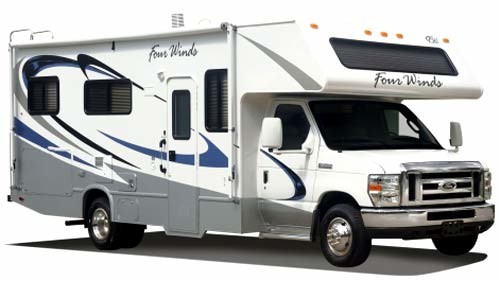
(Four Winds Class C motorhome).
The middle ground is termed “Class B,” or a camper van. The class has a lot to offer. They easier to drive than a big motorhome; usually get better miles per gallon; don’t require a toad (tow vehicle); AND you can park it in your driveway.
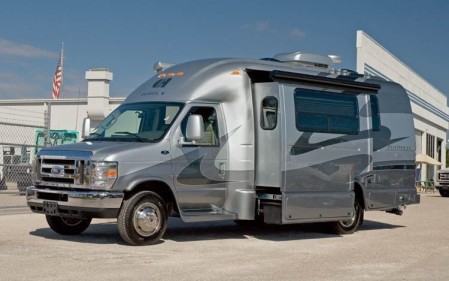
(The smooth curves of this Class B evoke the memories of the Airstream family of trailers, derived from the jigs that produced the B-29 Superforts of WWII).
In my mind, of course, nothing exceeds like excess and I was drawn to the Class A models:

(Monaco 45 Dynasty Motor Palace.)
Would that be a hoot? In the marvelous television show “Justified,” set in hard-scrabble Harlan County, Kentucky, middle-gangster Winn Duffy, played with malevolent glee by actor Jere Burns, lives in one like this in a variety of parking lots.
Here is the kind of lifestyle you can find in a Jayco Class A:
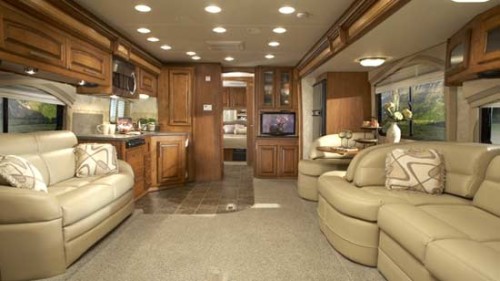
I am not sure I could keep a straight face and live in something like this. Could you? Where does the staff sleep?
Anyway, being my own bus driver comes with a laundry list of things I might (or might not) wish to do, and motoring in one of these probably would require towing a small car behind, making it the practical equivalent of being a traveling circus.
Still, as one alternate life-styler maintained adamantly: “I live on an acre of land in my fully-owned, Class A RV, with my own well water, for less than $500 a month, everything included. I spend about $300 month on food, gas up my hybrid once a month for only $30. I became a Minimalist after 9/11. Being a “Full-timer” in an RV is the best decision I’ve ever made.”
That is going a little further than I had contemplated, since I was mostly just concerned with snow avoidance. But the idea does have a certain minimalist attraction. But there might be a better way to explore the concept before putting all the retirement eggs in one “Class A” basket. I was looking at trucks, as I mentioned a moment ago.
Ruminating on the most popular vehicles in America, an alert car guy in Kalamazoo wrote to say: “The F series pick ups deserve their place as the best selling vehicle in the world for decades. As one of the hated “financial guys” at Ford, I can tell you that their financial genius and discipline is actually what gave it the great products and many years of business performance that exceeded all auto makers!”
In all our rambling around the great cars of the last century, we haven’t talked about the money that made it happen, and the financial genius that enabled Ford to survive the collapse of the industry in 2008 without government bail-out is another whole story, which would include the monetary sleight-of-hand that made Generous Motors originally a profitable concern, before it became a ward of the state. But that is a matter for another day, maybe a bleak winter one with a dusting of snow coming in and the engine block heater plugged in.
I was just looking at a truck that could haul a trailer, and get the hell out of here. This is what caught my eye this morning:

2010 F150 4X4, 29K on the odometer. It is capable of off-road autonomy, and could tow something like this retro baby, base price starting at $21 grand:
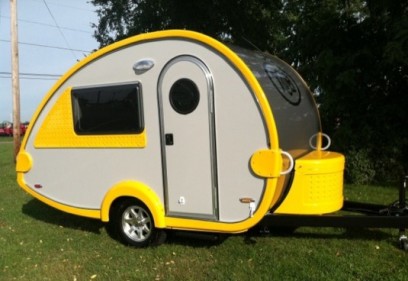
Come Thanksgiving, or should the Gales of November come early as they did to the ore-carrier Edmund Fitzgerald, this might be a place to spend a couple months living under a palm tree.
We’ll see. It might be fun. What did Nillson say about that? Go someplace where the weather suits our clothes?
Copyright 2014 Vic Socotra
www.vicsocotra.com
Twitter: @jayare303
Pick Ups
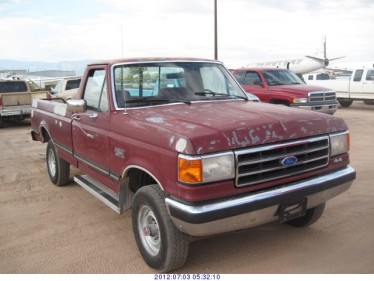
(1990 Ford F-250 Gas powered pick up truck.)
I have been feeling a little inverted of late- or maybe not inverted, per se, not that there is anything wrong with it, but maybe “sidewise.”
The working thing is losing its appeal. I am not going to the office any more- and the long road trip and the impending end of summer have me almost as distracted as the world situation, which is hurtling sidewise through some 8th Century hall of mirrors.
Other than that, things are great, right?
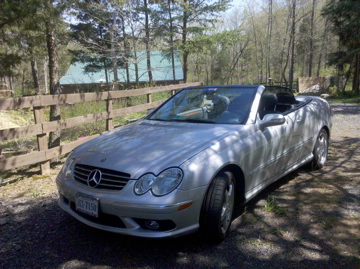
(The Hubrismobile at Refuge Farm. Coolest and most sophisticated car I will ever own.)
Over the last two thousand miles on the road, I have naturally had too much time to think. I love the fine German engineering of the Mercedes- the GLK-350 was a great decision, when I ditched the finest, most fun car I will ever own- the CLK-500 eight cylinder Cabriolet that radiated a certain unmitigated Hubris.
I have had enough of that in my life, or better said, the full consequences of my intrinsic have not caught up with me. Yet.
I am sure there is time enough for that, as Mr. Kipling observed about East and West, when we are all standing at “God’s great judgment seat.”
That can happen in a New York Minute, a matter I contemplated during one of those moments on the eternally-under-construction Pennsylvania Turnpike. You know- the stretches of Jersey Barriers that hem you in with no shoulder and an eighteen-wheeler drifting into your lane…
Anyway, the splendid handling of the Panzer made most of the journey a no-brainer, and I bounced between the unbelievable news and classic rock with restless ease.
Watching my fellow Americans motor along- the long-haul trucks and campers and trailers- I began to think about what is next in terms of wheels.
I don’t consider the Syclone to be a real truck. It is more a Corvette dressed up in Sonoma pick-up fenders, a high performing toy. Real trucks are something else much more emotional. Trucks carry things. Trucks move things and haul them- trailers for horses and firewood and even cars. Trucks move you from one home to another. You can sleep in them, if there isn’t something better to do. Trucks make you free in a uniquely American open road sort of way.
Out in Circus City, Joe lead me through the cemetery to find Cole Porter in his truck. He is an American Motors enthusiast, of course, but trucks are a category unto themselves. Looking for a decent motel one night on the Ohio road, I thought how cool it would be to have a trailer or an RV that I could just pull over in a likely place and spend the night.
So I started looking at the trucks on the road. There is a reason that of all the vehicles sold in America in 2013, three of the top five selling vehicles in America, three of them are pick-up trucks.
In fact, the top selling car in America- for the 32nd consecutive year, is a truck. Or rather, a family of them: the Ford F-series trucks. Regular, Heavy Duty and Super Duty, diesel or gas. That makes it at the start of the Reagan Administration. That is staying power.
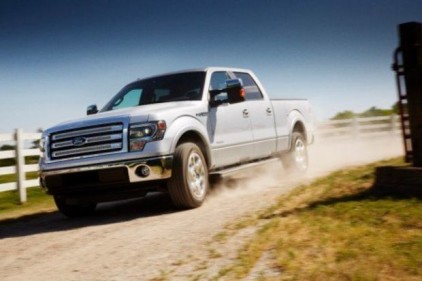
(2013 Ford F-150 pick up truck, most popular vehicle in America for the 32nd year).
I have a minor love affair with a 1990 F-250, but I am afraid we will have to get to that in the morning. And trailers, of course. But that goes without saying. Plus, it is going to be awfully handy to have a way to get a load of stuff out of town in a hurry, if it comes to that.
Copyright 2014 Vic Socotra
www.vicsocotra.com
Twitter: @jayare303
Afternoon in America
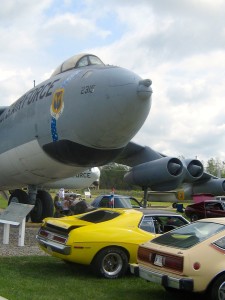
(My cousin James Burr flew this model B-47 for the Strategic Air Command. He was the youngest Command Pilot in SAC and was killed flying one in the line of duty. Under the imposing nose is a Spirit (right) and a Javelin. All photos Socotra).
The Panzer worked flawlessly across a couple thousand miles. It is a nice ride, and I was happy not to be watching a set of forty-year-old instruments as I rolled over Maryland and Pennsylvania and Ohio and Michigan and Indiana. I was saturated with satellite media on the Interstates and the Blue highways of the Great Heartland, and I had to marvel at the manifold follies of the wide world..
I have been staying away from things political over the last couple months- there is no point. The government doesn’t function in any manner I understand, so with that, any insight I might have gathered over the last four decades is either erroneous or irrelevant.
I was refreshed by the view of America- the real one- up close and at the middle distance. I wrote about Circus City- Peru, Indiana- and the wonderfully open people there. If you add the casual optimism of the American Motors Folks in with that, you could convince yourself that it is indeed Morning in America someplace.
I would never vote against this side of our national experience: good people with worthy, hard working hobbies.
I pulled into the Grissom Air Museum shortly before eleven; it had been nearly four hours from the Detroit suburbs, and the weather exactly matched the mood: fog, burning away to brilliant sunshine. I was overdressed- it had been a cool summer back in Arlington, Detroit was tepid, Indiana was hot. The sun beat down on the air park and I felt myself slipping away.
I looked around the grounds and there were classic AMC products spanning the 1950s, 60s and 80s neatly parked under the protective wings of warbirds. I didn’t know if the sunshine was going to hold, so I got right to work after turning some renderings that Raven did of his concept cars from 1950 over to the President of the Hoosier AMO Club, a Great American named Todd who was manning the gate.
Raven got a new AMC vehicle every year according to the terms of his contract, so it was sae to say that I had ridden in or flogged most of the cars that were there. What surprised me was that I had time in five of the museum static display aircraft, and Uncle Dick and Cousin Burr had been pilot-in-command of two more. I walked first to the F-4 Phantom:
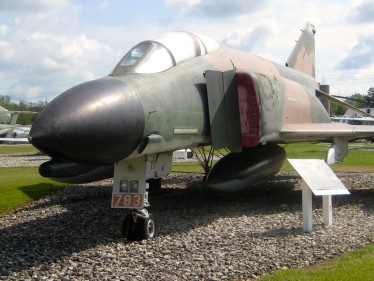
(This old warrior is the Air Force version of the renowned fighter. I got a ride in a VF-151 Navy F-4J off the USS Midway in 1980 and was treated to an inverted pass of Mount Fuji in Japan).
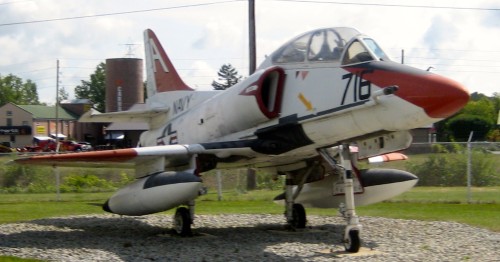
(This TA-4 Scooter is similar to the one I got a ride in to launch a drone off Roosie Roads in Puerto Rico. What a hoot! Grissom has some great Navy aircraft, since it once was Bunker Hill Naval Air Station.)
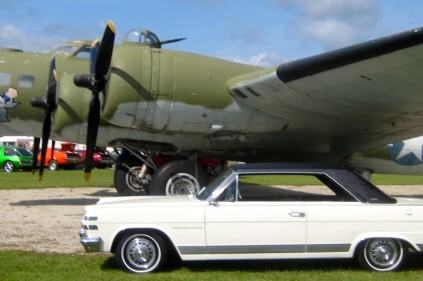
(B-17G Flying Fort similar to the one uncle Dick flew on D-Day over the Normandy Beaches. The sleek lines of the Ambassador sedan compliment the old warrior).
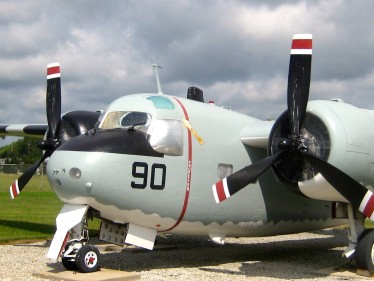
(Going temporary duty someplace I got a lift in a C-2 Trader like this one off Midway. For old times sake, they did a “deck launch,” in which the catapult was not used to launch the aircraft. It was completely Old School: the pilot drove aft to the landing zone, turned the aircraft into the wind, stomped on the breaks, went to military power and took off in the length of the ship. Amazing.)
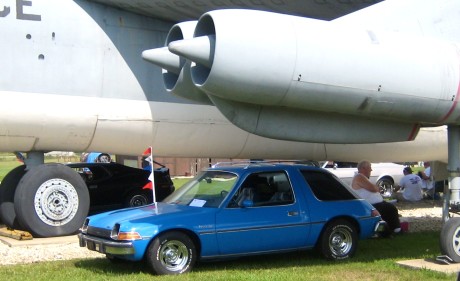
(The astonishing AMC Pacer tucked up under the wing of the B-47. The bomber could probably carry four of them on pylon stations for use against Russian targets).)
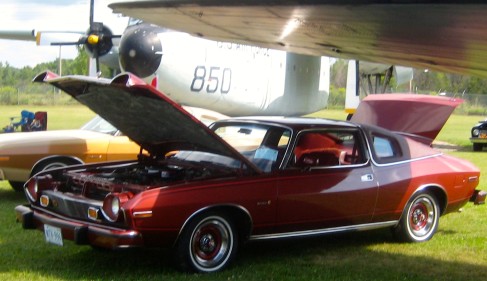
(AMC Matador under the wing of a B-25 Mitchell light bomber. Lovely specimen, both of them).
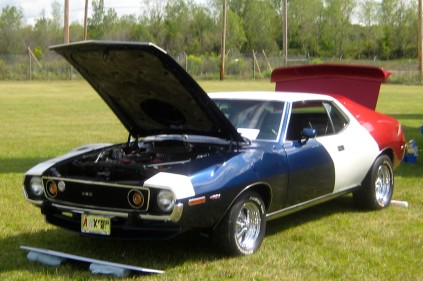
(Javelin dressed up in AMX colors. We had a 1968 Jav as Mom’s car- both my brother and I know it could do more than 120MPH).
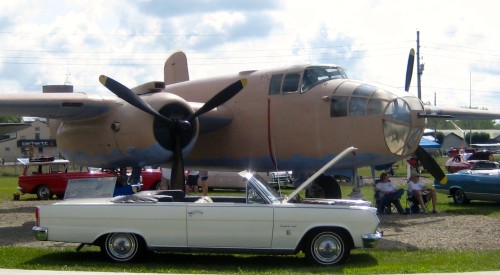
(Todd let me pick a car for the Bill Reddig Award. I had to think hard about that- so many cools cars and so many memories. I finally selected this cherry 1968 Ambassador convertible because I got in such trouble with one. Raven’s was canary yellow and I borrowed it to drive to Groves High School before the Big Game and got the door dented in the parking lot. We lost the game, too. Not a good day for me, but a splendid day for this special car. The trunk goes on longer than a Continental.)
When the show was over, the awards were presented and Raven’s renderings were raffled off. I will have to think of something to bring to Indiana next year. Then, when the tables were put away and the trash picked up, we drove off to the Mr. Weenie in Circus City.
I had the two Kraut Dogs and split an order of deep fried macaroni and cheese with Joe. It was an intensely emotional afternoon. This is the America I remember.
I was a pretty cool country. And being with the people and their cars and the airplanes that settled so much history in the skies over so many places, I realized that it still is.
Only a thousand miles at the wheel and I could be in my own bed again, and not worry so much about the fools were up to back in Washington.
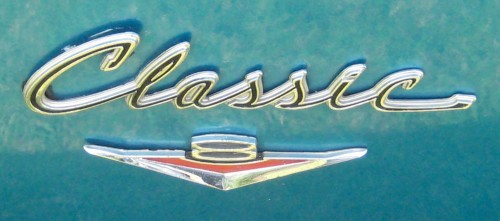
Copyright 2014 Vic Socotra
www.vicsocotra.com
Twitter: @jayare303
Where is Vic?
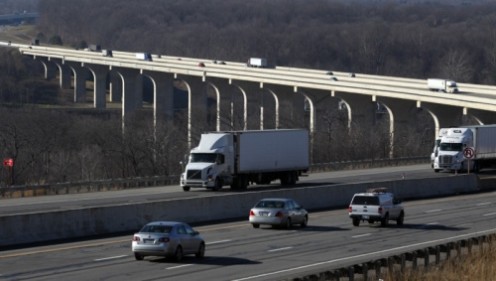
(Ohio Turnpike Bridge over the Cuyahoga River. It was reportedly not on fire when Vic passed by in the Panzer).
Many do not care, nor should they. However, for those few who have expressed concern that the Panzer may have plunged into the turbulent Cuyahoga River, or the placid Monongahela, he asked me to pass along the news that he is once again in Arlington after logging nearly two thousand miles on the SUV over the past five days.
“I had a chance to visit America,” he muttered. “I am exhausted, but last night I slept in my own bed, and that was grand, and took the opportunity to drive through that covered bridge in Newton Falls Ohio, which may be the second oldest in the Buckeye State but is the oldest actually in service, and a source of intense civic pride along with Tigers High School Football, and that guy in the bronze Toyota that almost side-swiped me on Ohio Route 5 missed, thank God, and now all I have to do is ignore the jihadis coming over the railings, forget the fact that I listened to the news for five straight days and that no one out there in the Real Country seems to be too fazed by anything and the car ran great and missed the big rainstorm, and life is pretty damned good, all things considered.”
I have no idea why he could not get it together this morning- I saw his light on at the usual ungodly time when I was coming back from the Blind Pig, and he was pounding away on his computer. I have no idea what he was doing if not the stupid morning epistle. When he called from the road yesterday, he said he was working on a big photo montage of the Hoosier AMO Club Bill Reddig Meet, and the jets and how people in the Heartland are about as kind and good as they get, and he was thinking about buying a Ford F150 pickup truck with a camper on the back and just checking out of the National Capital Region because everyone here is nuts.
As far as I know, he did not do that, but I had to crash when I got back to my place, and anything could have happened in the meantime.
I am confident that Vic will be “back in battery” one of these days soon. But like I said, anything could have happened in the meantime, and based on what is going on in the wide world these strange days, might have.
Cheers,
J.R.
Circus City
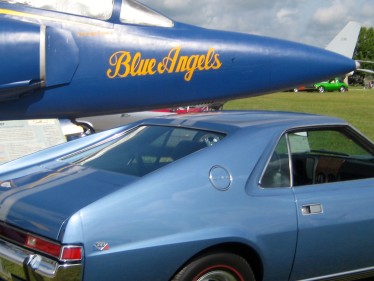
(Two magnificent machines at the Grissom Air Museum. Photo Socotra.)
I don’t like clowns. It is a professional thing. You know where I live, and that will have to suffice. But I was curious that the Circus City Best Western Motel was named that- which leads to a short tale of a visit to the real America, not the strange enclave where I hang my hat back in Northern Virginia.
This will have to be a two-parter, since I have travel today. This was a very emotional trip- the cars and the jets and the backdrop of this little American town is fascinating. The place is Peru, Indiana, pronounced just like the country in South America. Except, apparently, by some elderly residents who prefer the archaic “Peeee-Ru.”
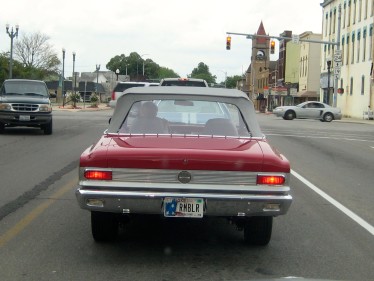
(Rambler American in downtown Peru, Indiana. Photo Socotra).
It is a treat to visit a city that only has 11,000 year-round residents and yet is so palpably alive. The town dates back to the 1830s, and was home to a Caucasian woman who was returned to her family after nearly sixty years of captivity by a local band of Native Americans.
Peru had a car company that failed (most towns here did) and a huge flood of the Wabash and Mississinewa Rivers that wiped the town out in 1913.
Four or five traveling circuses made Peru their winter quarters, and hence the nickname “Circus City.” Part time residents here included the cast of The Greatest Show on Earth and Buffalo Bill’s Wild West Show. To this day, the young people of the city put on a week-long circus festival, and even if I don’t like clowns, I would consider coming back to see it.
We were here for the Annual Show that the Hoosier American Motors Owners Club puts on. The venue this year was the historical aircraft collection at the former Naval Air Station Bunker Hill/Grissom AFB.
It was beyond cool, and I will get to that in another story more tailored to the Car People theme. Very emotional and it was well worth the drive to get across the rolling green terrain and the languid brown rivers and all that corn.
After the meet was wrapped up and ahead of the gathering thunderclouds, the Senior Leadership of the Hoosier AMO- Debbie, Joe and Todd- took me into town to see the iconic Mr. Weenie Drive-In restaurant. “Turn on lights for service!”
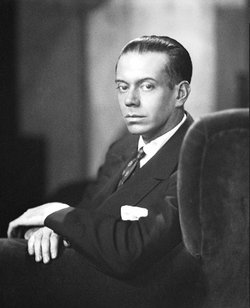
Sitting at the picnic table, I learned a lot about the history and context of this vibrant little town. Cole Porter, uber cool, uber sophisticated New York tunesmith was raised here. And he is buried here.
That isn’t all. There is a tradition of get-away cars, too.
Ace Criminal and domestic terrorist John Dillinger robbed the Peru Police armory, posing the rhetorical question “What better place to get such equipment than from the police themselves?”
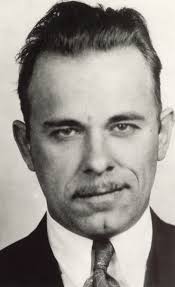
A week after Dillinger’s escape from the Lima, Ohio, jail, he and some confederates decided to hit the police arsenal in Circus City. A month earlier, Dillinger and Homer Van Meter had posed as tourists there and asked what the local policemen had in the way of fire power if the Dillinger Gang ever showed up in those parts. The officers proudly showed the two “tourists” the kinds of weapons they would use against the Terror Gang.
Late on the evening of October 20, 1933, Pierpont and Dillinger entered the arsenal, subdued three lawmen and made off with several loads of machine guns, sawed-off shotguns, ammunition and bullet-proof vests. Given the current discussion of the militarization of local police forces, it sort of puts things in context, you know?
When this loot was added to the guns and ammunition they had stolen earlier from an Auburn, Indiana, police station, they were ready for business.
Auburn was the site of last year’s AMO meet- coincidence? I don’t know.
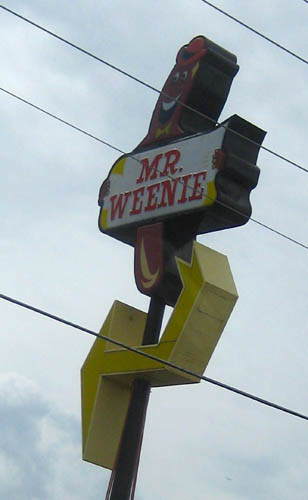
Mr. Weenie is a classic Drive In. Good root beer. The dogs were more iconic than good, but the deep-fried mac and cheese made you think hard.
The leadership wanted to get their pristine 1968 AMX and 1964 American convertible up the road before the rains came. I wanted to get the pictures edited and posted on my Facebook page, but I asked Joe if I could follow him in his truck past the cemetery and see if I could find Cole Porter.
We found him.
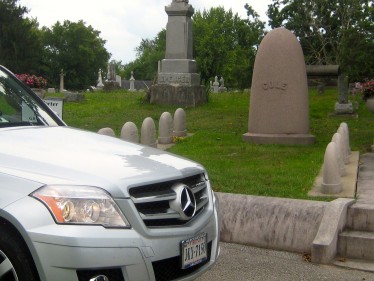
(Panzer and composer’s resting place at Peru’s Mount Hope Cemetery. Photo Socotra).
What a day- and that doesn’t even include the cars or the airplanes. More on that when I get to it.
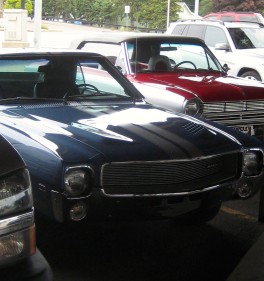
(AMX and American convertible at Mr. Weenie’s. Photo Socotra).
Copyright 2014 Vic Socotra
www.vicsocotra.com
Twitter: @jayare303
The Covered Bridge
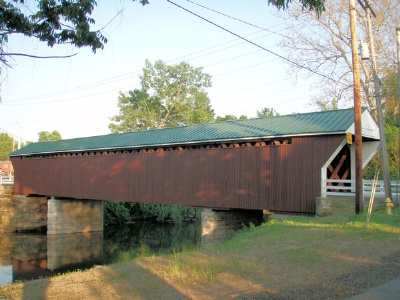
(The Bridge on- no kidding, Arlington Blvd in Newton Falls, Ohio.)
I woke in Newton Falls, OH, having run out of airspeed and good ideas around five-thirty last night on the Ohio Turnpike. I always feel better with the Keystone State behind me. Sam’s Pizza “A tradition since 1958!” provided the grub for dinner- delivery, what the hell- and between the general fatigue and such I selected a mostly white little town.
Actually, I knew the general region- off Ohio Route 5 somewhere around the Lordstown Generous Motors manufacturing complex- which is hiring, I was surprised to see, based on the banners hung from the security fences.
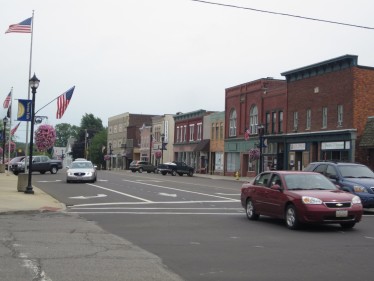
(Downtown Newton Falls. A nice community.)
The Garmen GPS selected the place, though I was able to fine tune it to the type. I don’t smoke at the moment, so most of the hassle of travel has vanished as the smoke blew away. I selected predictable over quirky. Previously, I looked for old-school motor hotels- that will be worth a story for the car book one of these mornings. You remember the kind- two long wings of single floor rooms, side by side, and parking directly in front of your unit. I liked being able to step outside and smoke, even if the room was “smoke free,” and to be able to watch the car.
It is liberating these days, if a Holiday Inn XPress can be considered liberation.The desk staff was helpful, the internet connection worked and though the walls and floors are thin, it was a perfectly decent accommodation (at the government rate).
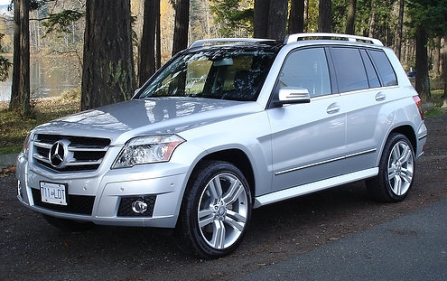
This is a car story, since I spent most of the day in the Panzer, and it was a depressing day. You know what I am talking about, and it was good to be in a little town that is calm, and whose people are unfailingly polite and upbeat.
I went over to look at the bridge, since it is the second oldest in all of the Buckeye State.
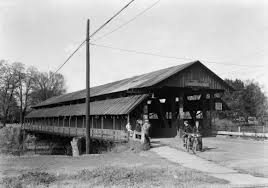
(This is what the Newton Falls Bridge looked like with the advent of the motor-car: they added a safe place for the kids to walk to the new school on the other side of the Mahoning River!)
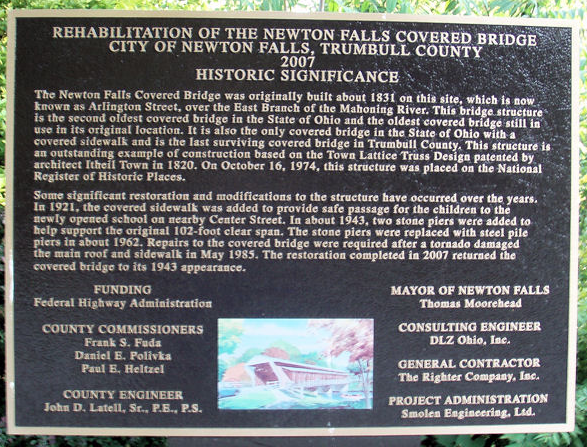
This is a nice place. It is an American place. I feel at home here, and the falls on the river that turned the generators to manufacture automobiles has helped make it that way.
More from Ramblerland on the morrow.
Copyright 2014 Vic Socotra
www.vicsocotra.com
Twitter: @jayare303
Coast to Coast
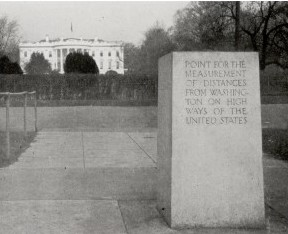
(Milestone Zero, Route 50, Washington, DC. Photo US Army)
I had intended to be further along on about ten things today, and the story is getting out the door later and later. It is OK, though. Car Week is over in Monterey, The Dream Cruise is about to begin on Woodward Avenue, and the placid fields of Indiana are calling. A century ago the idea of hopping in the car to drive to a destination a few states away would be unthinkable, but now, it is almost literally, a piece of cake.
This particular cake will be the color of the cement on the greatest construction feat of humankind, something bigger than the Great Wall of China, something to dwarf the Pyramids. A monument so massive it can be seen from space, and the remains of which will last as long as the continents.
I am completely confident that Ike Eisenhower would agree with my priorities, since he was a man who liked his challenges.
We have talked a lot about our crazy love affair with the carburetor- now the fuel injector, but all that would be for naught without our freeways and turnpikes and those annoying State Patrol ambush sites all along the way.
You would have to start with the visionaries who organized the movement to promote The Lincoln Highway, a bold vision of a paved road all the way from New York to San Francisco.
Imagine what the country looked like then. In 1912, the great 19th century marvel of the intercontinental railroad dominated inter-state transportation. Roadways were primarily things of local interest. Outside the metropolitan areas, “market roads” were maintained by counties or townships, but there was no state bureaucracy to maintain an integrated network.
Maintenance of most rural roads was the responsibility of those who lived along them, which is to say that the entire country had signs announcing “State Maintenance Ends.” In fact, many states had constitutional prohibitions against funding basic infrastructure such as road projects, and federal highway programs were not to become effective until 1921, due to the publicity raised by a spectacular Army project.
Let’s take a look at what things were like as the new motorcars began to change America. At the turn of the century, the country had about 2.2 million miles of rural roads, of which less than 9% had “improved” surfaces: gravel, stone, sand-clay, brick, shells, oiled earth. The rest were dirt. Inter-state roads were considered a luxury, something only for wealthy travelers who could spend weeks riding around in their automobiles.
The New York Times called for a system of improved interstate roads in an article in 1911, just as the diggers were completing the biggest public works effort in human history at the Panama Canal. It was the American Century, for sure, and the Nation could achieve anything.
President Robert P. Hooper of the American Automobile Association and Speaker of the House Champ Clark thought that the time had come for the “general Government to actively and powerfully co-operate with the States in building a great system of public highways…that would bring its benefits to every citizen in the country.” However, Congress as a whole was not nearly as progressive as it is now. Most of it felt the idea of a national network or highways was just too expensive.
Why, you might as well want to go to the Moon, you know?
But think back. Way back. In the summer of 1919, the young Lieutenant Colonel Ike was just back from France, and he jumped at the chance to join the first Army motor convoy across the country.
It was an impressive stunt, and one that was direly needed by the War Department, headquartered in the massive Munitions Building next to the Reflecting Pool on the National Mall.
With the War to End Wars just concluded, America at that moment was not sure that it needed much of a standing army, and a demonstration of capability had to be a good thing when the Armed Services Committee met on the Hill to consider the Army’s future budgets.
The Army devised an idea of dispatching a column of vehicles from coast to coast, from the reflecting pool in Washington all the way to the Presidio in San Francisco. The idea was a thoroughly Army sort of thing: it would feature a convoy of eighty-one motorized Army vehicles. The convoy would cover a distance of 3,251 miles in just over two months. A speech about progress and the national defense need for Good Roads would to be made at each stop, which was at least as important as the trip itself.
Ike hated that part of it, and when he finally got a chance to control when and where the speeches were made, he kept them short and business-like.
The last time I crossed the country by car, sixty-five years later, the trip from ocean to ocean took not quite four days. I was not pushing it and no one was particularly interested in what I said when I periodically emerged from my 1990 Dodge Shadow four-banger turbo.
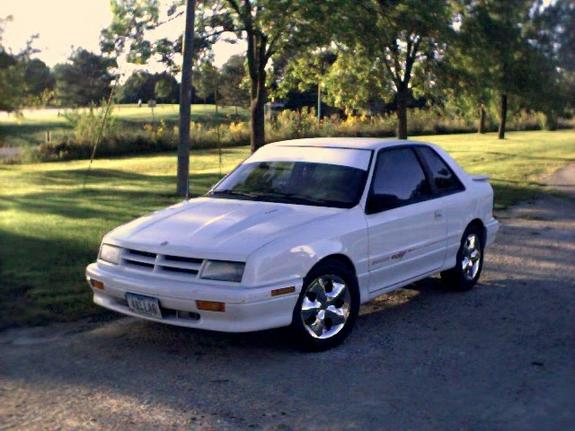
Not true back in the day. The Convoy left the Zero Milestone in Washington, DC, and headed north and west through Arlington to cross the Potomac near the Point of Rocks, the place where the Confederate armies had passed north into Maryland on their way from Culpeper to Gettysburg to the High Watermark of the Lost Cause.
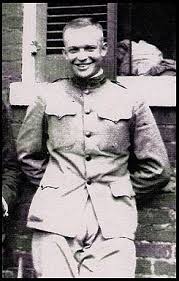
Young Ike Eisenhower joined the convoy in Frederick, Maryland, on the night of the first encampment. He was along mostly for the adventure, since the expedition was a demonstration of the phenomena that career military officers know well. The war was over, there was excess capacity in the force, and there was a clear and present need to preserve resources that had to be avoided at all costs.
The transcontinental convoy was something that still resonates because of the profound way it affected the nation, and saving the Standing Army. Lt. Col. Eisenhower learned first-hand of the difficulties faced in traveling great distances on roads that were seasonably impassable, and not much improved most places from the days of the wagon trains.
Lt Col Charles W. McClure and Capt Bernard H. McMahon were the respective expedition and train commanders[ of the expedition, and of course there was a train to carry spares- this was the Army Green Machine, after all. Civilian Henry C. Ostermann of the Lincoln Highway Association was the guide- there was no standard system of road signs in those days, and in many ways the expedition was relying on compass and motorcycle scouts for navigation..
It was a major production number. The Signal Corps documented everything on film, there was a band, and the Public Affairs Officer rode a week in front of thee main body, followed by the recruiter and the chow hall workers.
Two motorcycles scouted about a half hour ahead to report conditions and place markers for the Field Artillery 5 ½ ton Mack trucks, which were in turn followed by a mobile machine shop and a unit of the Quartermaster Corps bringing up the rear.
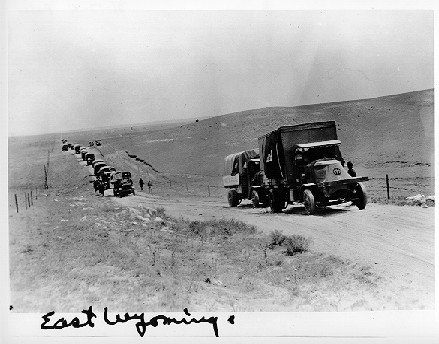
It was the Wild West, literally. There were 230 road incidents, which included stops for adjustments, extrications, breakdowns and accidents. The 81 vehicles in the Convoy and trailers included “34 heavy cargo trucks, 4 light delivery trucks”, three mobile machine and blacksmith shops, a wrecking truck, and the “Artillery Wheeled Tractor.”
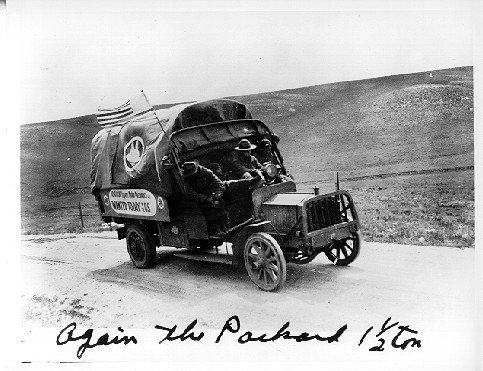
Nine trucks did not complete the route, but the great automakers of the day all got a chance to showcase their wares: Liberty and Mack trucks were lead by Cadillac, Dodge, Garford, Packard, Riker, Standardized, Trailmobile, and White all rolled on Firestone tires. Harley-Davidson, Indian provided the scout bikes).
Dealers en route supplied gasoline and tires out of patriotism and for advertising. It was both a spectacle and spectacular. By the time the column passed out of the Land of Lincoln, virtually all the roads were dirt. The Convoy broke 14 bridges in Wyoming, and soldiers repaired them.
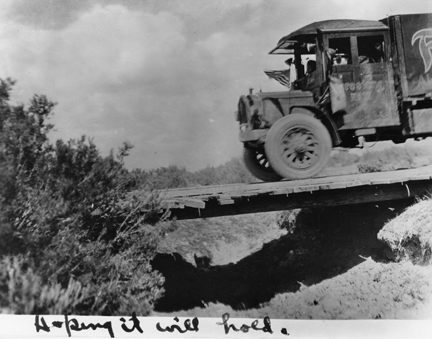
The convoy travelled at breakneck speeds up to 32 mph, and intended to average 15 mph speed of advance. The reality was not nearly so good. With delays and repairs, the actual trip across 3,250 miles required 573.5 hours and averaged only 5.65 mph over the 56 days. The Average travel day was ten and a half hours.
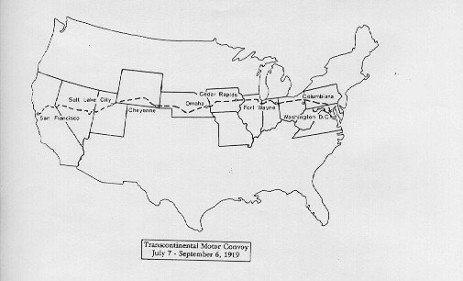
They stopped for six rest days, at East Palestine, OH, Chicago Heights, IL, Denison, IA, North Platt, NE, Laramie, WY and Carson City, NV. The mud, tough terrain and inadequate bridges held them up, and the convoy did not demonstrate the crisp military adherence to schedule. Falling nearly a week behind, they skipped a last rest day at Oakland, CA, and took the ferry across the bay to park in triumph, finally, at the old Spanish fortification of the Presidio in San Francisco.
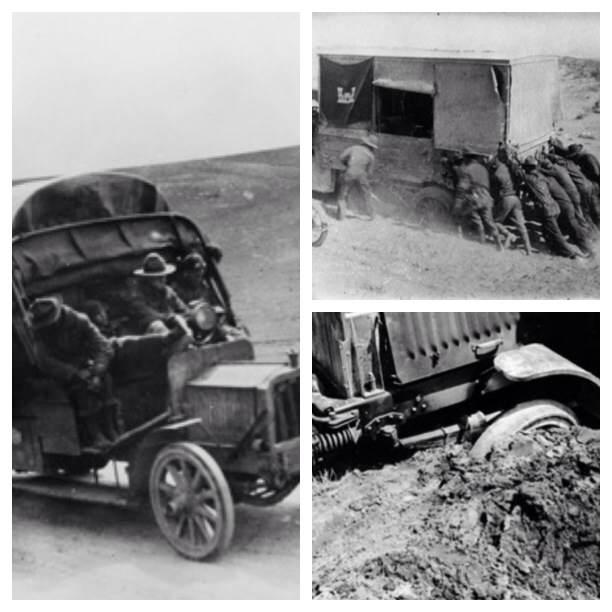
The path had been conquered, coast-to-coast, and the nation followed the Army’s progress with breathless interest. It did not save the budget, per se, but it did spur interest in a national network of roads for smooth transit from coast to coast.
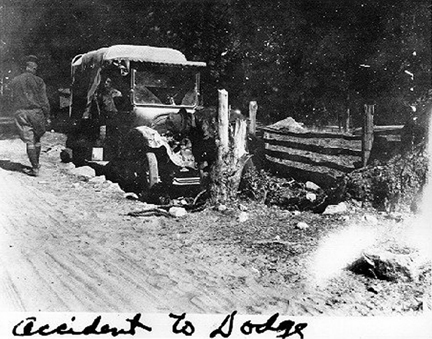
One of the matter-of-fact lessons the future General of the Armies learned was that the nation needed a good and uniform system of roads, and that a high-speed network of them was not only a matter of safety and commerce, but a matter of national security.
It was the beginning of something so profound as to defy easy description. With the good roads movement, the development of the auto and the byways on which it was appearing in increasing numbers gained momentum. A commission in 1926 designated names for all federal highways in the forty-eight states. Highways going east to west were given even numbers, and highways going north and south were given odd numbers. Major coast-to-coast highways were assigned numbers ending with zero.
The road that ran out of DC was called Route 50, and The National Boulevard got a number to go with its name.
The Depression-era Works Progress Administration provided “shovel ready” road projects through the tough times, under the rubric “Farm to Market” work across the country.
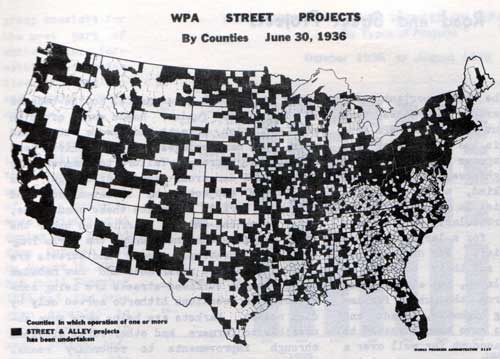
(Depression-era Works Progress Administration road works by county. Photo WPA).
World War II and victory over Germany and Japan opened the floodgates on consumer demand for automobiles and new tract housing and new roads to carry them.
Ike assumed the Presidency in 1952. He remembered his trip thirty-odd years before vividly- in retirement he devoted a whole chapter titled “Through Darkest America With Truck and Tank” in his 1967 book At Ease: Stories I Tell to Friends. His exposure to the autobahn network in Germany combined a profound understanding of both the need and the solution. In 1954, he announced his “Grand Plan” for highways.
On June 29th, 1956, he signed the Interstate Highway Act, which was effectively going to kill the downtown district of every big city. It was OK. America was becoming a place where everyone could aspire to have a couple of automobiles.
The miracle of the superhighway: The Dwight D. Eisenhower National System of Interstate and Defense Highways. What a way to roll.
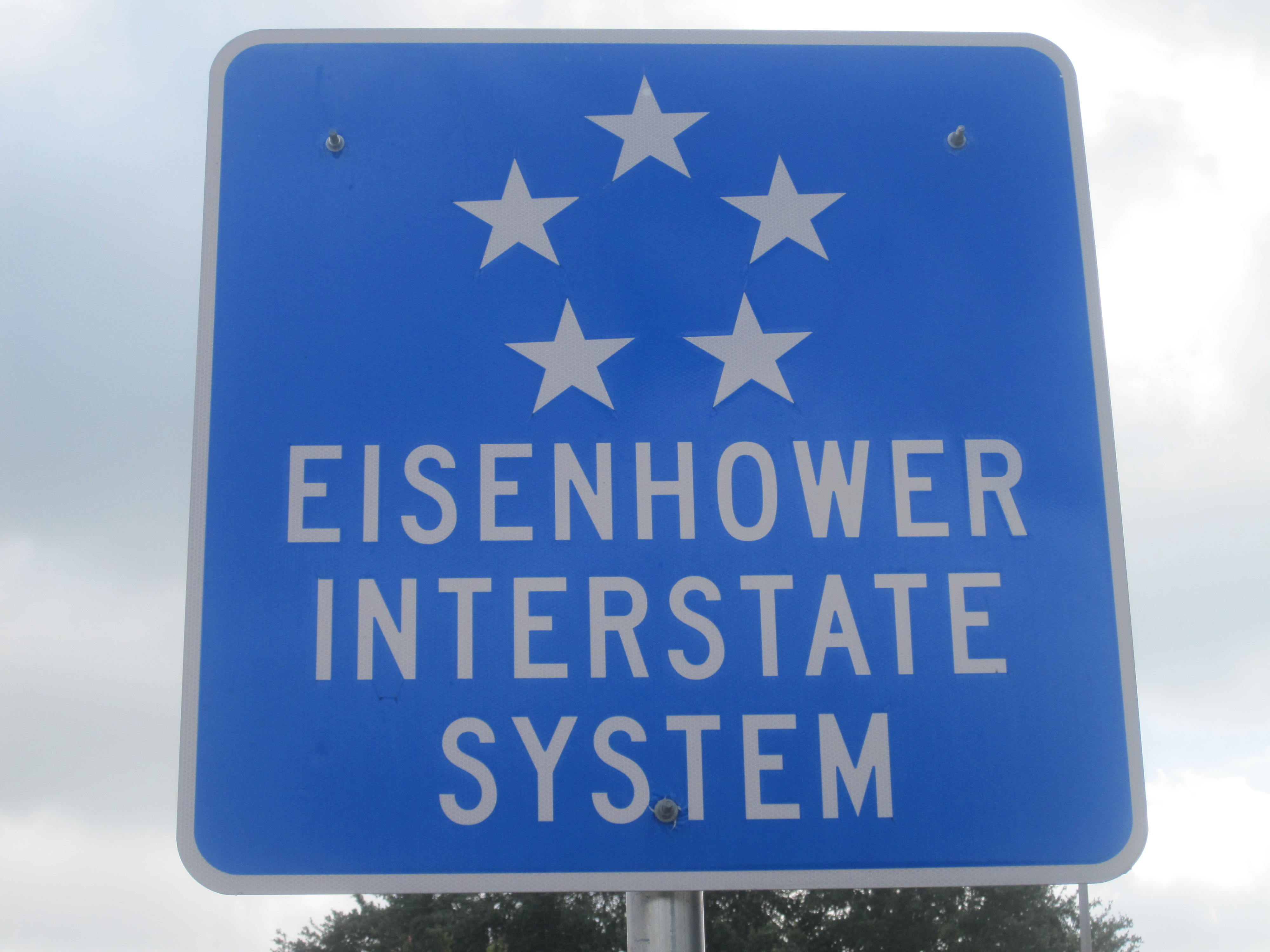
Copyright 2007 Vic Socotra
www.vicsocotra.com
Twitter: @jayare303
The Passion Pit
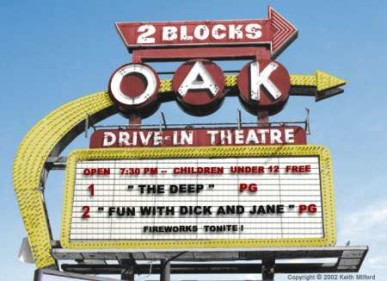
(The Oak Drive-In Theater sign on Woodward, just two blocks away on Normandy Street in Royal Oak with the dancing hot dogs on the screen at intermission and the playground for the kids under the screen until it got dark enough to start the movie! Photo Keith Milford).
I got lost this morning- sorry. I ran across something I wrote a long time ago about a (personally) interesting trip to the Oak Drive-In during which something improbable happened in the red VW Beetle. That was the significant drawback to the German car, which in most other respects was an admirable bit of transportation.
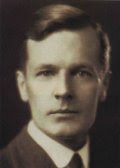
(Nash Motor’s Nils Eric Wahlburg in the 1930s)
There was something much cooler for the Drive in- and it was the product of the American Motors Corporation, and one of the most unsung innovators in Detroit iron. Nils Eric Wahlberg had many inventions to his credit- the fully-unitized/monocoque body construction, a manufacturing process still in use today (the 1940 Nash 600), the “Weather-Eye” integrated automotive heating and ventilation system (also in the1940 Nash) and the seatbelt and padded dash being just a few of them.
My favorite though has left a legacy on at least two generations. Invented in 1936 to accommodate the needs of traveling salesmen, campers and a Depression-era America on the move, Charlie Nash introduced the “Bed-In-A-Car” feature.
This revolutionary innovation allowed the vehicle’s interior to be converted into a sleeping compartment. The rear seatback hinged up, allowing the rear seat cushion to be propped up into a level position. This also created an opening between the passenger compartment and the trunk. Two adults could sleep in the car, with legs and feet in the trunk, and heads and shoulders on the rear seat cushions.
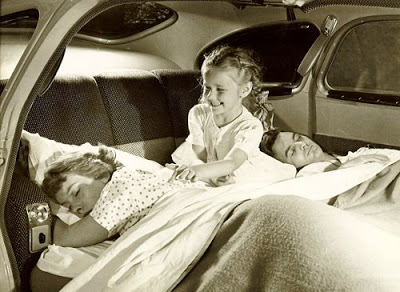
In 1949, possibly to accommodate the Greatest Generation that was creating Boomers out of whole cloth, so to speak, the arrangement was modified so that the front seats fully reclined, creating a sleeping compartment completely within the Rambler’s passenger space.
In the 1949 Nash Airflyte, these reclining seatbacks were given the ability to lock into several intermediate positions, which George Mason dubbed the “Airliner Reclining Seats.”
They were also known as other things, but they were perfect for another innovation of the time that really took off after the war: The Drive-In Theatre.
Richard Hollingshead was a young sales manager at his father’s Whiz Auto Products, whose mother, it is said, was a woman of some substance. In fact, she was substantial enough that she had difficulty in fitting into a seat at the walk-in movie theater.
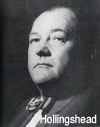
(Richard Hollingshead, King of the Drive-In Theater).
Hollingshead combined his love of cars with that of the silver screen. His idea was to create an open-air movie theater where moviegoers could watch from the safety and comfort of their own automobiles where they could smoke, drink, babysit and generally behave as they wished. He experimented in his own driveway in Camden, New Jersey, until he got it right.
He put his mother in the passenger seat and mounted a 1928 Kodak projector on the hood of his car, projected onto a screen he had nailed to trees in his backyard, and used a radio playing behind the screen for sound.
Hollingshead subjected his configuration to rigorous testing. To simulate inclement conditions, he used a lawn sprinkler. With innovative ramps he created the perfect parking topology for unobstructed views and created the drive-in movie theater experience.
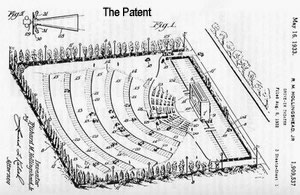
He was awarded United States Patent #1,909,537) on May 16, 1933, and with the backing of some fellow visionaries, put together $30,000 to break ground. Hollingshead opened the first drive-in on Tuesday June 6, 1933, on Crescent Boulevard in Camden. The price of admission was 25 cents for the car and 25 cents per person, and the first carload of kids hiding in the trunk followed in short order.
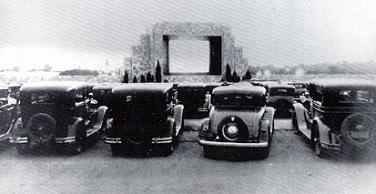
(The very first American Drive-In Theater in Camden, NJ)
The design did not include the in-car speaker system we knew in the 1950s and sixties, before the theaters began to broadcast on their own low-power AM and FM transmitters direct to the radios in the cars. RCA Victor agreed to provide “Directional Sound” from three main speakers mounted next to the screen. The quality sucked, particularly for those who parked in the rear of the lot for reasons best known to themselves.
Eventually the iconic metal speakers connected to poles by curly cables in each parking place became the industry standard, and there are few teenage drivers who did not have to explain to Dad how the car got damaged by driving off with them still hooked on the driver’s side window.
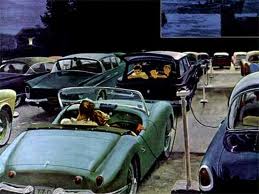
(Saturday Evening Post version of the American Drive-In).
The theaters were large and small; the largest was the All-Weather Drive-In of Copiague, New York, with space for 2,500 cars, indoor seating for 1,200, a playground, full service restaurant and a shuttle train that took customers from their cars and around the 28-acre theater lot.
Ed Brown’s Drive-In & Fly-In of Asbury Park, New Jersey, had the capacity for 500 cars and 25 airplanes. The Oak had a respectable 1,000-car capacity, and a cool snack bar, if you had not brought your own popcorn, as Raven and Big Mama did when they took their three tykes to the show. Sometimes there were fireworks after the movies were done.
Sometimes the kids were still awake for it, and I can remember being carried into the house from the 1948 Ford.
In their heyday, in the late 1960s, fully 25% of all American movie screens were in Drive-Ins; that plummeted in the great decline to less than 2% by 2013.
Several explanations have been offered for the decline; the rise of the VCR and DVD, along with 500 cable channels at home. To try to buck the trend, some theaters abandoned the family entertainment model and went porn, which pitted operators against local blue-noses. Many were just overcome by urban sprawl and no longer made sense as real estate.
The OAK went bust with the last show in the dark on October 30th, 1980, showing “Caddyshack” and “Up the Academy.”
It was a sad evening. The Oak turned into an industrial park. As it turned out, the Rambler’s folding seats outlasted most of the Drive-Ins, but there is a spirited movement to retain the 350-odd theaters that remain, and some guerilla capitalists are even opening a few new ones.
I mean, there are things you can do in your car that are even more exciting than just watching the show, you know?
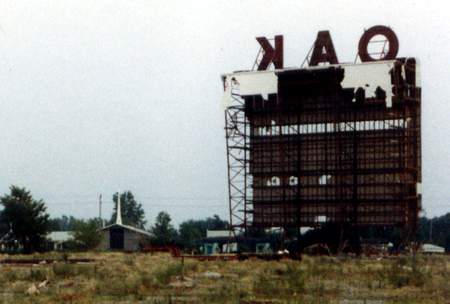
(The Oak Drive-In during demolition. Photo Greg O’Sullivan).
Copyright 2014 Vic Socotra
www.vicsocotra.com
Twitter: @jayare303
Demolition Derby
I am overwhelmed by the automobiles at the culmination of the Monterey, California Car Week: The Pebble Beach Concours D’Elegance. It quite takes my breath away, it being light years away from my price-point for automotive fun, which runs more to the demolition derby.
Our pal Mules volunteers to keep order at the Concours, watching to ensure the millionaires don’t riot or start looting. He had the early shift, and was there for the 0600 watch on the Stillwater Cove gate. at the far end, the tee area of the 18th fairway of the Pebble Beach course and the early morning drive-on:
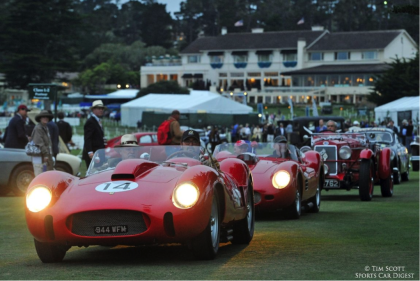
(Photographer Tom Scott caught the formation arriving to take their places on the 18th fairway of the famed Pebble Beach Country Club).
“Some 220 prized cars stretched the length of the fairway, coming from five continents, 17 countries and over 3 dozen states….
The duties at the little-used entrance passed quickly and then it was my ‘car time’….. this is my 7th or 8th Concours, I know the layout and the routine…. but the bottom line is.. given the numbers, the variety and the crowd…. it’s hard to cover it all… and it’s one of those hard to describe events … without seeing it….”
The Concours is something very special- this year there were seventeen of only 99 Rucker automobiles ever built- they were the first front wheel drive cars, luxurious beyond belief, and I had never even heard of them before I got the summary note from Mules.
Between the various shows and auctions, something like a third of a billion dollars was spent on exotic motorcars this week in Monterey. It is a world apart from the one I am looking at this Monday morning at the farm. I ache from the stoop labor of yesterday- weeding my driveway, of all things, and my fingers are mangled from grasping for the pesky tap-roots amid the gravel.
I have other chores this morning- starting the Syclone, which is ready for another round of restoration, and the LTJG’s explorer after policing up the piles of mown grass in the front yard. I was about ready to collapse when I was done right around cocktail hour, and picked up this week’s edition of the Clarion-Bugle to catch up on local events in bustling Culpeper.
I was thunderstruck when I saw the article below fold by freelance writer Wally Bunker. The Spite House on Fleet Wood Hill is coming down!
My research indicates there is no relationship between the Cadillac Fleetwood and the history site of the heaviest fighting in the Battle of Brandy Station. There is a tangential relationship between the famous battle- largest cavalry engagement in North American history- and my Ford Crown Victoria P-71 Police Interceptor, when I drove it there one time to inspect the ground.
Looking at the commemorative marker near the summit of the hil, I discovered that I was also looking into the garage of Mr. Tony Troilo, whose family had lived on the summit for many years. The site had been the headquarters of General J.E.B. Stuart, and stayed in private hands after the war. Word was that the garish mansion was in retaliation for no one having deep enough pockets to pay what Mr. Troilo wanted for the property.
I don’t know about that, but I do know this: last year, several hundred preservationists (and me) donated modest sums to raise funds for the Civil War Trust to buy Tony for $3.6 million. In exchange, the Trust gained title to the land soaked with the blood of Rebels and Union troopers amounting to 56.5 acres at the epicenter of the fierce fighting on June 9, 1863.
There are also two houses, outbuildings, and an in-ground pool.
The battle marked the beginning of the Gettysburg campaign, the high watermark of the Confederacy, and the occupation of Culpeper by U.S. Grant’s Army of the Potomac the following winter.
Other actors in the great drama who appeared on Fleet Wood include Col. John S, Mosby, the famed Gray Ghost who conducted a daring twilight raid on Union wagons left behind when Union forces headed to the Mine Run Campaign. Mosby and 125 Partisan Rangers burned 40 wagons, took 23 Union prisoners and captured 112 mules and seven horses before heading to Woodville in Rappahannock County.
According to Bunker, “Demolishing the modern day structures will clear the hill to make it look somewhat like it did more than 150 years ago.. The newest and largest, which has been characterized as a McMansion, was occupied by the Troilo family in Dec. 2007.”
It is an ugly house, and it despoils a place that should be viewed as a national monument. I look at the damned thing everytime I drive to the farm in the Panzer of the Police Interceptor.
This is how it looked when I first got the Bluesmoibile:
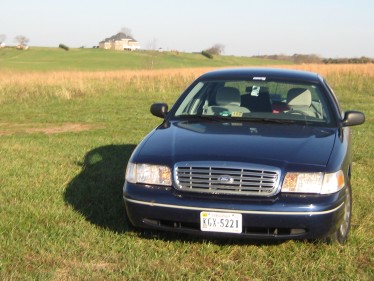
(The 2004 Crown Vic P-71 Police Interceptor on the battlefield with the Spite House over its imposing right shoulder. Photo Socotra).
“It was a home,” Troilo is quoted as saying. “Now, it’s a house.” I am looking forward to when it will not be a house, but be gone, and the foundation hauled away. With the millions in his pocket, Tony can be philosophical. Bunker quotes him as saying that his father told him never to fall in love with material possessions, incluing houses.
“You never love something that can’t love you back.”
I don’t know about that. I love history, and I respect the history that happened on that hill. And I have to say that this news makes me happy.
I may not love my cars, but I do have to say that I have an extraordinary fondness for them. Which is not to say that the demolition derby can’t be grand fun, too.
Copyright 2014 Vic Socotra
www.vicsocotra.com
Twitter: @jayare303
